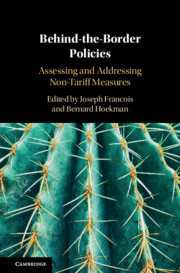Book contents
- Behind-the-Border Policies
- Behind-the-Border Policies
- Copyright page
- Contents
- Figures
- Tables
- Boxes
- Contributors
- 1 Moving beyond the Border
- Part I Concepts and Measurement
- Part II Assessing and Benchmarking Policy
- Part III Dealing with Non-tariff Measures: Legal and Institutional Contexts
- 8 Nontariff Measures Reforms
- 9 Good Regulatory Practices and International Trade
- 10 Rules of Origin as Non-tariff Measures
- 11 Behind-the-Border Measures and the New Generation of Trade Agreements
- 12 Nontariff Responses to China’s Development Strategy
- 13 A Time for Action
- References
- Index
8 - Nontariff Measures Reforms
A Practitioner’s Perspective*
from Part III - Dealing with Non-tariff Measures: Legal and Institutional Contexts
Published online by Cambridge University Press: 25 October 2019
- Behind-the-Border Policies
- Behind-the-Border Policies
- Copyright page
- Contents
- Figures
- Tables
- Boxes
- Contributors
- 1 Moving beyond the Border
- Part I Concepts and Measurement
- Part II Assessing and Benchmarking Policy
- Part III Dealing with Non-tariff Measures: Legal and Institutional Contexts
- 8 Nontariff Measures Reforms
- 9 Good Regulatory Practices and International Trade
- 10 Rules of Origin as Non-tariff Measures
- 11 Behind-the-Border Measures and the New Generation of Trade Agreements
- 12 Nontariff Responses to China’s Development Strategy
- 13 A Time for Action
- References
- Index
Summary
Nontariff measures (NTMs) are regulatory instruments and policies that apply to traded products. Insofar as NTMs address a market failure and improve the business environment they are fully justified on welfare grounds. A badly designed or implemented NTM, however, could unnecessarily restrict trade and work against the realization of trade facilitation objectives. A common feature of efforts to reduce the trade-impeding effects of NTMs and improve the business environment is to increase the transparency of prevailing NTMs and to ensure that such measures are not more trade restrictive than necessary to achieve the legitimate policy objective of each specific regulation, such as protecting the environment, human health, animal well-being, etc.
- Type
- Chapter
- Information
- Behind-the-Border PoliciesAssessing and Addressing Non-Tariff Measures, pp. 179 - 192Publisher: Cambridge University PressPrint publication year: 2019

